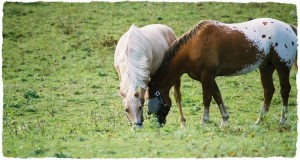Natural Boarding & why we do it…
Natural Boarding has many benifits, I’d like to explore the different aspects of why keeping your horse in as natural setting as possible is so important…
(Article below is by www.all-natural-horsecare.com)
Natural boarding recognizes the fact that horses are herd animals who need the company of other horses 24 hours a day. They need to interact by touching and playing. Through evolution as a herd animal, horses are programmed to know that safety is in numbers. So a solitary horse is often a stressed horse.
Natural boarding methods are based on the study of how horses live in the wild. They are designed to meet the basic physiological needs of the horse and are the foundation of all natural horse care.
Herdlife…
Horses are very social animals so herdlife is very important to them. In the wild their lives often depend on it. They feel safer in open spaces where they can see all around them. As prey animals they have evolved to rely on safety in numbers – the more eyes watching out for predators the better!
Horses that are stabled and deprived of contact with other horses often develop vices such as wind sucking and weaving. They can become depressed and withdraw into themselves. Sometimes they become aggressive. These vices are the only way they are able to express themselves. When the horse is put under such stress then the digestive and immune systems are affected making the horse more susceptible to illness and disease.
Given enough space horses love to romp, play and hang out together. This also helps develop social skills that help keep harmony in the herd. In the wild most horse families are made up of a single stallion and a number of mares. One of these mares will be the stallion’s favourite. She will be dominant (the alpha mare) and lead the herd, including the stallion. Within the rest of the group there will be a pecking order which is established through daily interactions.
Horses also like to groom each other. This helps to get to those itchy spots that they can’t reach by themselves. Often they will stand head to tail so that they can swat flies away from each other’s faces. This is why it is important for them to have the company of equals rather than other species such as cows or sheep.
Living Outside…
Horses have developed an extremely efficient thermoregulatory system in their skin. It is through the skin that the horse gains information about the environment. But for it to work properly they need to have constant access to that environment which is why horses are healthier living outside year round.
Each individual hair in a horse’s coat has a small muscle attached to it. This enables the horse to raise and lower the hairs to change the thickness of the coat. When the horse is cold it will raise the hairs so they can trap a layer of warm air. The air is warmed by the heat loss from the horse’s skin and the hairs prevent the air from escaping. As the horse warms up the coat will be flattened. This in turn decreases the amount of insulation and varies the amount of airflow to the skin.
Just like any other muscle the hair muscles need to be exercised to perform properly. When a horse is kept in a stable in a fairly constant temperature the muscles do not get exercised. This impacts on the horse when the rug is taken off when going for a ride. Suddenly the horse is subjected to much lower temperatures and it’s muscles aren’t able to respond effectively.
When a rug is put on the horse the hairs are forced to lie flat. This means that the horse no longer has control over regulating it’s temperature. Often the horse gets too hot under the rug and it is helpless to do anything about it. However the uncovered parts of the horse still get cold so the horse tries to warm them up which in turn make the areas under the rug even hotter. If the horse starts sweating under the rug it lowers the temperature too much as the moisture is trapped and the horse’s system will suffer. As a result the chemical processes within the horse may be partially disabled which will allow diseases such as colds and flu to take a hold.
Horses can also generate heat through muscle action when moving. This is another good reason for allowing horses to live outside where they have space to move around. Or if the horse doesn’t want to move it can create the same effect by shivering as this also generates heat through muscle use.
Rugging and stabling a horse prevents the horse from growing a thicker coat in the winter. Also too much grooming can strip the coat of its natural greases which are there to keep it waterproofed. So try to avoid over grooming in the winter and keep bathing to a minimum.
Horses are adapted to deal with colder conditions. It is much easier for them to warm up than to cool down. Unlike a dog, a horse cannot use panting to lower it’s temperature. It relies mainly on sweating. The sweat glands secrete fluid which cools the skin surface as it evaporates. The sweaty horse will raise the hairs in it’s coat and turn them in different directions to allow the air to dry the sweat. In a stable there is very little airflow so the sweat takes longer to dry which can lead to chilling.
——————————————————-
In Part 2 we will cover the topics of Movement and Grazing.


